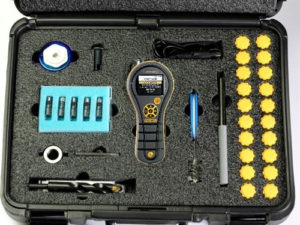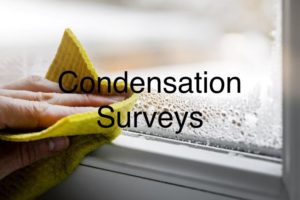Condensation Survey & Report Specialists.
Is Condensation Dampness & Black Mould Driving You Doolally? Call: 0800 246 5668 or Request a Survey HERE
Adept UK independent damp & mould surveyors have been helping to reduce condensation and damp issues in properties throughout the UK for well over FORTY YEARS. We pride ourselves in our customer services and look forward to demonstrating how our condensation specialists & damp experts can assist you and your problems.
Condensation & damp mould problems can cause significant damage to properties, and if left untreated it can take a long time and be very expensive to repair. Damp and mould surveyors acting on behalf of homeowners, landlords, tenants, solicitor’s, letting agents & housing associations.
Damp & condensation problems can lead to further issues including mould, decorative spoiling & damage to furniture and house contents. Of the many problems that can affect your home over time, dampness & condensation are two of the most troubling. Damp mould is capable of affecting the whole structure of your property and can also result in health problems for residents. These problems cause stress and worry, for homeowners, rental property’s for tenants, private landlords & management letting companies. 
Damp mould and condensation look’s unsightly, despite regular cleaning, so it is essential to deal with the root cause. Obtaining an independent damp mould survey & report is advisable for an accurate and informative diagnosis, using plain English, with no hidden agenda of obtaining works or materials that are often ineffective and often not needed. Our specialist damp and mould surveyors are accredited Certificated Surveyors in Remedial Treatments (C.S.R.T ) (C,T.I.S.) qualifications recognised by the Property Care Association (P.C.A) Formally known as the (BWPDA) (British Wood Preserving & Damp Proofing Association)
Moisture vapour in warm air is released as moisture droplets when it comes into contact with cold surfaces. (known as the dewpoint temperature where the air can no longer hold the moisture as vapour). It is apparent on non-porous material such as windows, tiles and painted walls. It is less noticeable on porous material such as wallpaper, soft furnishings, carpets and clothes as these absorb the moisture and it is usually the appearance of damp mould growth which first alerts the occupants of a property to the problem.
Measurement of Relative Humidity to Determine Dew Point
 It is a comparatively simple matter with the aid of a surface thermometer and hygrometer to measure wall temperature and Relative Humidity within a room and, by reference to charts to determine the Dew Point. Digital thermometers with air and surface probes are now available, as are digital hygrometers which give direct readings of Relative Humidity. Certain electrical moisture meters used within the industry are equipped with adequate surface thermometers and Relative Humidity can be determined with the use of a wet and dry bulb hygrometer (whirling type). Having determined the Relative Humidity and noted the air temperature in the room the Dew Point can be found by reference to a chart. If the surface temperature is at or below the Dew Point, the active condensation will be occurring at that moment in time.
It is a comparatively simple matter with the aid of a surface thermometer and hygrometer to measure wall temperature and Relative Humidity within a room and, by reference to charts to determine the Dew Point. Digital thermometers with air and surface probes are now available, as are digital hygrometers which give direct readings of Relative Humidity. Certain electrical moisture meters used within the industry are equipped with adequate surface thermometers and Relative Humidity can be determined with the use of a wet and dry bulb hygrometer (whirling type). Having determined the Relative Humidity and noted the air temperature in the room the Dew Point can be found by reference to a chart. If the surface temperature is at or below the Dew Point, the active condensation will be occurring at that moment in time.
Condensation Survey Report
 Musty smells in kitchen cupboards and bedroom wardrobes, visible green mould found growing on shoes and curtains, steamed up windows all the time, black mould in corners and cold areas, and a damp clammy feeling? All of these are likely to indicate a condensation dampness problem. Arranging a professional condensation survey with Adept UK independent damp and mould surveyors is a sure and safe way to ensure that your condensation damp and mould problems are identified and rectified before any further damage can be caused.
Musty smells in kitchen cupboards and bedroom wardrobes, visible green mould found growing on shoes and curtains, steamed up windows all the time, black mould in corners and cold areas, and a damp clammy feeling? All of these are likely to indicate a condensation dampness problem. Arranging a professional condensation survey with Adept UK independent damp and mould surveyors is a sure and safe way to ensure that your condensation damp and mould problems are identified and rectified before any further damage can be caused.
Damp and mould surveys carried out by condensation specialists will be able to diagnose the cause and report on any damp problems after a damp mould inspection our surveyors will provide advice and guidance to effectively prevent the damp mould issue from recurring. If necessary, we have a range of professional condensation solutions to deal with persistent condensation problems that risk deteriorating into serious problems. Continue reading to find out more about our damp mould surveys then simply fill in our contact form above.to arrange your condensation survey.
Condensation Survey Investigation
At a time and date convenient for you, condensation surveyors will visit your property to survey the cause of the condensation and dampness. Over the course of the survey our damp and mould specialists will:
- Condensation specialists will examine the affected and surrounding area to determine the cause of the condensation & black mould problems.
- Condensation specialists will conduct a full assessment of the property in order to establish if there are any other risks or problem areas in your home.
- Assess the suitability of ventilation in place at the residence, such as bathrooms & kitchens
- Damp and mould surveyors will report and advise you on the most efficient and reliable way to solve your condensation problem in your loft or home.
- Damp and mould surveys with report for landlords, tenants, property letting management agents & housing associations.
- If necessary, you will then be supplied with a full and comprehensive survey report that will outline the observations and recommendations made by our damp and mould surveyors.
Take the first step towards controlling condensation in your home with an independent damp and mould survey with report.
Aspergillus is an extremely toxic mould which causes damage and rot in many properties, and can come with some serious health risks to vulnerable people if ignored. Under the right conditions, and if left undetected mould can lead to health problems such as allergens, respiratory infections, allergies and asthma. They can also affect your immune system.
C.S.R.T. surveyor’s and trained specialists will create a detailed condensation report to find the cause of your problem and explain to you how to fix it. We’ll give you the confidence for us to tackle the problem with a solution that works first time. Condensation Report for commercial and residential properties throughout the UK.
You can rest assured that our industry leading damp and condensation surveyors are equipped with unrivalled knowledge and experience when it comes to investigating, diagnosing and prescribing treatments for condensation problems.
Our network of surveyors across the country ensures that the fully qualified surveyor who visits your property will be a local expert while our qualifications from various trade bodies provides assurances that we conform to and surpass the highest industry standards.
In order to attend your property and conduct a condensation survey it is essential that we speak to either the homeowner or landlord first. If you are renting or otherwise do not own the property then you may wish to talk to your landlord or local housing authority to discuss arranging a condensation survey.
COMMON SIGNS OF CONDENSATION DAMPNESS FOUND ON WALLS IN HOMES.
Black mould growth – which typically occurs on cold external walls and windows, in poor ventilated areas especially on walls behind furniture and in corners, in UN-ventilated cupboards, wardrobes or corners of rooms and black mould growth can appear at both floor and ceiling height.
WHAT ARE MOULD AND MILDEW AND WHY DO THEY OCCUR ON WALLS?
Mould is a kind of fungus that develops from airborne spores. It usually grows in damp, warm conditions without much airflow, which is why household bathrooms and loft spaces often suffer from mould. It is often simply caused by humid conditions and lack of ventilation, but sometimes mould on walls can be due to plumbing leaks, both inside and outside the property. Badly insulated heating pipes can also cause a build-up of moisture behind the walls. Mildew is the name for the most common type of black mould on walls, characterised by spots that can then spread over larger areas if left untreated. To find out if you have mildew on your walls, apply some bleach onto the affected area with a cloth. If the dark colour fades after a few minutes, it’s mildew. If not, the patch is probably just dirt.
CAUSES OF CONDENSATION
Air in occupied buildings will always contain moisture from activities such as bathing, cooking and washing/drying clothes. Moisture will also enter a building due to the evaporation of water penetrating from the outside caused by building defects. If this moisture is not vented to the outside, the humidity within the property rises and leads to black mould on bedroom, kitchen walls, and ceilings.
Some common modern-day problems which cause condensation damp, especially in older buildings which are being refurbished or modernised are:
- Installation of double-glazed window units without the appropriate provision of supplementary ventilation.
- Installation of showers, Jacuzzis, & saunas with insufficient provision of extractor fans.
- Tumble driers which are not vented to the outside.
- The blocking of existing vents designed to vent air to the outside.
- The sealing of roof voids by the installation of insulation, preventing an adequate through-ventilation via the roof vents in the eaves.
- The blocking of windows or vents to basement areas.
- Drying clothes on radiators.
- Using paraffin or flue less calor gas heaters.
WILL DEHUMIDIFIERS HELP STOP CONDENSATION?
De-humidifiers can reduce condensation effectively when rooms are warm and damp, but are of limited benefit when they are cold and humid. In domestic buildings, simple lifestyle changes that lower humidity and/or keep surface temperatures above “dew point” will tend to provide a more practical and less expensive long-term cost-effective solution. Similarly, whole-house ventilation systems, which can have a role in controlling condensation dampness, should not automatically be seen as the answer.
If you need to know how much it costs to carry out a specialist condensation survey / Inspection to a property which you let out or own for signs of any condensation & dampness related issues then contact Adept UK to request a survey for condensation
OVERCOMING CONDENSATION
Dampness is a real problem and where it persists a specialist surveyor should be engaged to explore the cause of the problem and provide advice or propose solutions. We have listed just a few of the possible methods of controlling the problem below.
Simply heating the air is unlikely to be a satisfactory solution, not only on grounds of cost, but also of practicality. Unless cold surfaces are eliminated, condensation is almost inevitable. Any remedial action, therefore, must involve both a lowering of moisture levels and the elimination of cold surfaces.
Improved heating and ventilation coupled with specific action in relation to cold spots will usually result in a significant improvement in conditions, although there may be circumstances in which alternative methods are required. A modest but constant background heat is preferable to intermittent heating since this will help to maintain a higher ambient temperature in the fabric of the building.
The installation of a small extractor fan in a kitchen or bathroom will carry away moisture-laden air from the two areas most responsible for condensation with minimal running costs. This is now required by the Building Regulations in new constructions. Extractor fans are now available which incorporate a humidistat which will control the operation of the fan within certain humidity limits. It is also possible to install fans that have an integrated heat exchanges. These have the advantage of providing effective ventilation while reducing heat loss from the property.
Condensation specialists assessing homes
Musty smells in cupboards and wardrobes, green mould growing on shoes and curtains, steamed up windows all the time, black mould in corners and cold areas, and a damp clammy feeling? All of these are likely to indicate a condensation dampness problem.
All types of buildings get condensation from time to time. It becomes a problem when conditions allowing condensation persist for long enough to allow moulds to grow. Condensation is an increasingly important problem, and is the most common form of dampness in UK buildings today. Concern for energy conservation, cutting of ever more expensive heating bills, and finite energy resources has resulted in more draught proofing and better insulation. Unfortunately, this has often reduced air movement in buildings to the extent that condensation takes place and mould growth occurs, with possible damage to building contents, fabric, and health of occupiers.
Condensation occurs when the balance between heating, ventilation and insulation in a building gets upset. This may be due to improvements such as double glazing, which reduces draughts but also reduces ventilation and air circulation, or central heating when radiators are badly located. Additional loft insulation is a third common cause of condensation when not well fitted.
Condensation inspections in homes cover sources of excessive moisture, as well as heating, ventilation, and insulation matters. They include checks on temperature and RH (relative humidity) conditions in a building, often in a number of rooms, and surface temperature measurements, particularly in likely cold spots. Likely sources of airborne moisture are inspected, such as Kitchens, Utility Rooms, Bathrooms. The location and operation of heating systems such as central heating radiators and boilers are checked. Location of furniture can have a major role. The construction of the building can also have an effect. Solid concrete lintels can form “cold bridges”, and porches in older houses are often of inadequate thickness, allowing heat loss as well as possible rain penetration.
Specialists can advise a range of control measures, from laundry and heating system use, extractors, cooker hoods, aspects of interior design, to insulation and whole house ventilation units.
Homeowners and private landlords can be faced with repair and fitness for habitation claims based on mould and condensation. We can assist with impartial advice clearly split into design and facilities aspects (usually under the landlord’s control), and occupation issues.
Condensation in homes is more prevalent during the colder winter months with the presence of black mould, wet walls and musty smells. If left unattended the cost of damage could be high, however, by having a survey / inspection carried out, by our specialists can help you resolve the problem by advising of cost-effective condensation solutions which are advantageous, particularly for landlords, tenants, letting companies, property management agents, & social housing associations.
As condensation occurs only when conditions allow, inspections at other times may not always detect it. We can obtain data over a period of time with dataloggers, and show what has happened during that time.
Specialist surveyors will inspect your home / tenanted property to identify the cause of the condensation and black mould problem and provide a condensation specialist dampness report detailing the extent of the problem, along with damp control and black mould solutions to solve the problem.
Adept UK – Avoiding Condensation Problems
Adept UK – Avoiding Condensation Problems Have you ever noticed water droplets on your window or black staining on your walls? Have you ever wondered why the moisture returns around your windows after you have wiped it away? This type of moisture is from the interior air and is commonly referred to as condensation. What is condensation and how does it form in my home? Condensation occurs in your home when moist air comes into contact with a surface which is at a lower temperature.
Moist air contains water vapour — commonly referred to as humidity. Indoors, we can increase humidity through our activities and lifestyle. If a surface in your home is cold enough, the air in the immediate vicinity of the surface will be cooled sometimes causing the moisture in the air to condense or change into a liquid on the surface.
Condensation forms first on the coldest surfaces of a room, usually on glass surfaces of windows and doors. These surfaces are typically cooled by lower exterior temperatures during the winter months much more so than during the summer. For example, if it is cold enough outside and/or warm and humid enough inside, condensation may occur on or around your windows resulting in fogging, water or ice on the windows themselves or even a puddle of water on the window frame or sill.
Other examples of condensation in your home can include damp spots or mildew/mould on outside walls, in corners and on ceilings. Areas of your home with poor air circulation, such as behind furniture or in a cupboard or fitted wardrobe, can also be susceptible to condensation.
Condensation forms first on the coldest surfaces of a room, usually on glass surfaces of windows and doors. If a surface in your home is cold enough, the air in the immediate vicinity of the surface will be cooled causing the moisture in the air to condense or change into a liquid on the surface.
A small amount of condensation appearing on a surface may not necessarily be a problem, depending on the amount of moisture that forms, how long it stays, and whether it accumulates on surfaces that can be damaged by water. Condensation can be short-term during a severe cold spell, or occur in a localized area such as kitchen, bathroom or laundry room.
In many instances, condensation moisture simply evaporates back into the air once the surfaces warm up or the moisture source is reduced. An example of this is moisture that condenses on a bathroom window during a shower and quickly disappears shortly after the shower is turned off. However, as a general rule, steps should be taken to avoid condensation problems wherever possible as moisture can lead to damage.
Damp survey, timber survey for house purchase, combined damp and timber survey, specialist timber and damp reports for mortgage providers, damp-proofing quotation and woodworm treatment are provided by Adept UK in the following North West, Midlands and South East regions / areas.
Birmingham, Cheshire, Chester, Wrexham, Lancashire, Liverpool, London, Manchester,
, North Wales, Shropshire, West Midlands,

